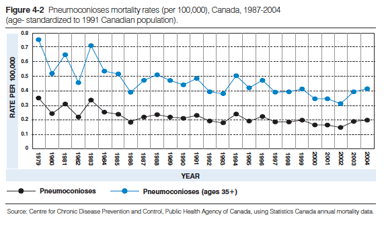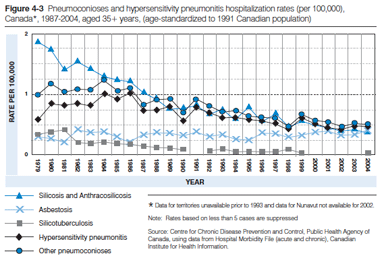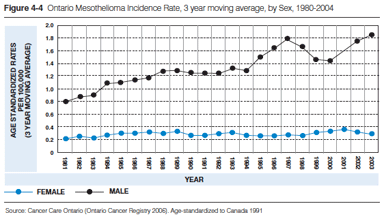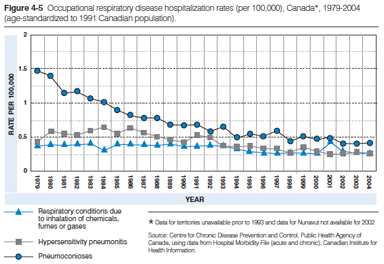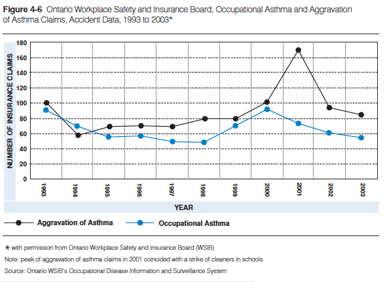Occupational Respiratory Disease
Introduction
Occupational respiratory diseases are caused by workplace exposure to irritating or toxic substances that may cause acute or chronic respiratory ailments. In Canada, as in other developed countries, there have been significant changes in the prevalence of occupational respiratory diseases over the past 30 years. Pneumoconiosis (lung disease resulting from inhalation of inorganic dust in mines and other work places) has declined. Although Canada is rich in minerals, and mining continues to be relatively common in many parts of the country, pneumoconiosis has declined both as a cause of recorded mortality and hospital admissions (Figures 4-1 and 4-2). Occupational asthma is now the most frequently compensated occupational lung disease through workplace compensation.
Pneumoconiosis
Pneumoconiosis includes silicosis, coal workers’ pneumoconiosis, and asbestosis, as well as historically less common diseases such as talc-related lung disease, siderosis, stannosis, bauxite lung (from aluminum), graphite lung and lung disease from beryllium. Even including hypersensitivity pneumonitis from organic dusts, yearly hospital admission rates in Canada have been only 1 or 2 per 100,000 population since the early 1990s, with mortality rates below 0.25 per 100,000 population, and less than 0.5 per 100,000 population among those 35 years of age and older. Figure 4-3 shows the rates for hospital admissions among those 35 and older, separated into hypersensitivity pneumonitis and various pneumoconiosis. There has been a decline in admission rates for all pneumoconiosis except asbestosis over time, as might be expected with better preventive measures at work. Reasons for lower rates of hypersensitivity pneumonitis are unclear, but they may be related to better control of exposures for some causes of hypersensitivity pneumonitis, such as in farmers’ lung. These trends, similar to those reported in the United States, likely reflect improved occupational hygiene conditions in mines, better dust control, and better use of respiratory protective measures.
Asbestosis is an irreversible condition caused by inhaled asbestos fibres. Given the long latency of asbestosis and reduced exposure in the past 20 years, a further decline in hospitalizations may eventually be expected for this disease.
Mesothelioma is a malignant tumour affecting the lining of the chest or abdomen caused by asbestos exposure. Figures were not available for mesothelioma under the ICD coding system until the introduction of ICD 10 codes in 2001, and there are no current national estimates for this complication of asbestos exposure, as ICD 10 codes were not implemented in all provinces until 2006. However, the numbers of (pleural) mesothelioma cases reported by Cancer Care Ontario (Figure 4-4) have demonstrated the marked rise associated with asbestos exposure decades earlier.
Beryllium disease results from the inhalation of beryllium dust. Although provincial compensation data indicate that chronic beryllium disease has not been commonly reported, this condition may have been under-recognized and sometimes misdiagnosed as sarcoidosis. The increased use of beryllium in manufacturing, and the recent introduction of the beryllium lymphocyte proliferation test for diagnostic use and for medical surveillance of beryllium-exposed workers, may increase the diagnosis of chronic beryllium disease.
Conditions due to inhalation of chemicals, fumes or gases
In contrast to the trends for pneumoconiosis, hospital admissions rates for respiratory conditions due to inhalation of chemicals, fumes or gases remained steady from 1979 to 2004 (Figure 4-5). Respiratory conditions resulting from the inhalation of chemicals, fumes or gases were responsible for 7 deaths between 2000 and 2004. The specific causes and exposures leading to these hospital admissions and deaths are not identified in the hospitalization database. The exposures which may lead to these respiratory conditions include acute occupational or non-occupational accidental exposures to respiratory irritants such as may result from fires; spills of chemicals such as acids; mixing of cleaning chemicals such as bleach and ammonia; and gases such as nitrogen oxides from silos, or phosgene.
Occupational Asthma
In many Canadian jurisdictions, as in other industrialized nations, occupational asthma (asthma attributable to occupational exposures) is the most common of the chronic occupational lung diseases compensated for by workers compensation. Data on occupational asthma are not routinely collected as there is no specific ICD code that defines it in the hospital admissions and mortality data.
In the absence of a specific ICD code, hospital admissions and mortality due to occupational asthma can be estimated by linkage with other databases, such as compensation data. However, these likely underestimate true cases of occupational asthma, since not all cases are clinically recognized or have compensation claims submitted. The limited Canadian (Ontario) data reported from linkage of compensation data with hospital admissions and mortality have suggested significantly increased rates of hospitalization for asthma (28-fold) and respiratory diseases (5-fold) among those compensated for occupational asthma, though approximately 50% less than that occurring in tertiary asthma clinic patients.1 National data are not available on rates of confirmed occupational asthma.
Limited data from asthma questionnaires have suggested that up to 36% of adult-onset asthma in Canada may have an occupational component.2 An American Thoracic Society analysis of published studies suggests an occupational contribution in 10%-15% of asthma overall.3
Previous Ontario compensation data indicated relatively stable rates of occupational asthma between 1993 and 2002 (Figure 4-6). While there has been a trend to falling rates of total adult hospital admissions and mortality from asthma, this does not necessarily reflect a reduction in incidence or in the socio-economic effects of occupational asthma or work-aggravated asthma.
Other occupational lung diseases
Other occupational lung diseases for which ICD codes currently cannot provide diagnostic information include occupational lung cancer (from agents such as asbestos, chromium, radon), and occupational chronic obstructive lung disease (attributable to occupational exposures in an estimated 15% of cases).3 Numbers available from compensation boards are likely to be markedly underestimated.
Summary
In summary, the information available has provided encouraging information as to declining rates of pneumoconiosis in Canada but has raised concerns as to increased rates of hospital admissions and mortality from respiratory exposures to chemicals and other agents. Before preventive measures can be taken, however, further definition will be required. Other diseases of concern which cannot be evaluated from the available ICD coding system for mortality and hospitalization include work-related asthma, chronic obstructive lung diseases and occupational lung cancer.
1 Liss GM, Tarlo SM, Macfarlane Y, et al. Hospitalization among workers compensated for occupational asthma. Am J Respir Crit Care Med 2000; 162:112-118.
2 Johnson AR, Dimich-Ward HD, Manfreda J, et al. Occupational asthma in adults in six Canadian communities. Am J Respir Crit Care Med 2000; 162:2058-2062.
3 Balmes J, Becklake M, Blanc P, et al. American Thoracic Society Statement: Occupational contribution to the burden of airway disease. Am J Respir Crit Care Med 2003; 167:787-797.


